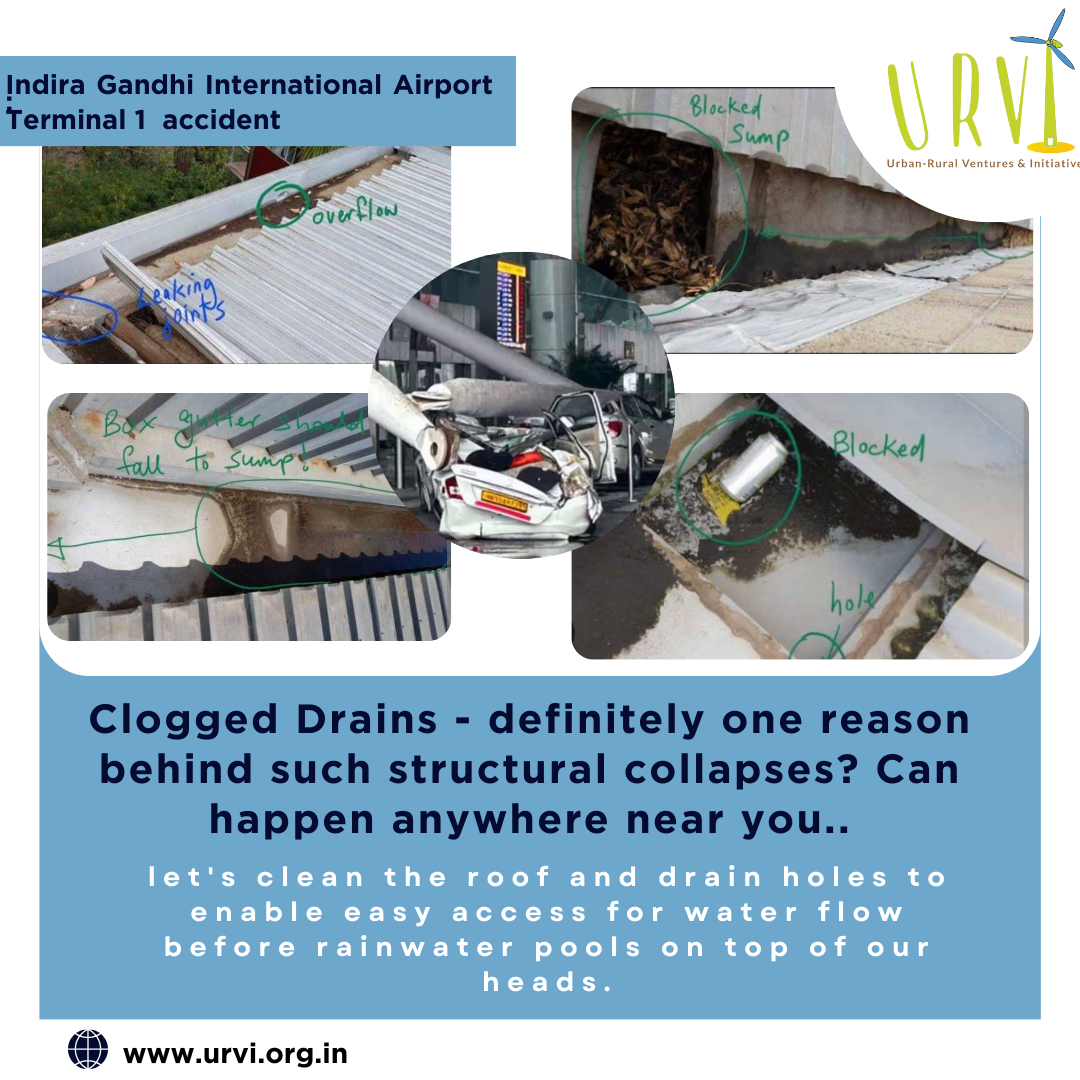
Prevent Accidents like IGI Terminal-1 Collapses: Pre-Monsoon Maintenance Tips
The tragic collapse of a portion of the roof at Terminal-1 of Delhi’s Indira Gandhi International Airport during a monsoon has left us all shocked and saddened. This incident, which killed a taxi driver named Ramesh and injured six others, serves as a stark reminder of the critical importance of maintaining rooftop and drainage systems. In this guide, we'll explore essential tips to help you prepare your buildings for the monsoon season and prevent such devastating events.
Cleaning rooftops and drainage holes before the rainy season begins is a simple yet effective measure. This task involves removing debris, leaves, and other blockages that can obstruct water flow. Regular cleaning ensures efficient drainage, preventing accumulation and potential structural damage.
Consulting a Qualified Drainage Design Professional
When considering modifications to roof drainage systems, always consult a qualified drainage design professional. These experts can assess your building's specific needs and design efficient systems. Their expertise ensures that any changes will enhance drainage performance without compromising structural integrity.
Maintaining Drains, Scuppers, and Plumbing
Regular maintenance of drains, scuppers and plumbing is necessary. Regular inspections help identify and eliminate blockages, ensuring that these systems function properly during heavy rains. Schedule periodic checks to keep your drainage systems in top condition, reducing the risk of water accumulation and structural damage.
Effective coordination among the design team is crucial, especially for relatively flat roofs. While drainage design may not typically fall under the structural engineer's scope, collaborating with other professionals ensures a comprehensive approach to building safety. This coordination helps address potential drainage issues.
Understanding Roof Drainage and Structural Design Loads
It’s vital to understand how roof drainage impacts rainwater structural design loads. Poor drainage can lead to water accumulation, increasing the load on the roof and potentially causing structural failures. By collaborating with drainage professionals, structural engineers can design systems that effectively manage these loads.
Indicating Rainwater Design Loads on Structural Drawings
Although not always required by building codes, it is a best practice to indicate estimated rainwater design loads on structural drawings. This information helps ensure that all design and maintenance efforts take into account the potential impact of heavy rainfall, enhancing overall building safety and planning.
The Importance of Rooftop and Drainage Maintenance
Water accumulation during heavy rains can be disastrous, weakening the structural integrity of buildings and leading to severe damage or even collapse. Proper drainage systems play a vital role in preventing water buildup, ensuring safety during the monsoon. Real-life examples, like the IGI Terminal-1 collapse, illustrate the consequences of neglecting drainage maintenance.Essential Steps for Building Owners and Managers
Regular Cleaning of Rooftops and Drainage HolesCleaning rooftops and drainage holes before the rainy season begins is a simple yet effective measure. This task involves removing debris, leaves, and other blockages that can obstruct water flow. Regular cleaning ensures efficient drainage, preventing accumulation and potential structural damage.
Consulting a Qualified Drainage Design Professional
When considering modifications to roof drainage systems, always consult a qualified drainage design professional. These experts can assess your building's specific needs and design efficient systems. Their expertise ensures that any changes will enhance drainage performance without compromising structural integrity.
Maintaining Drains, Scuppers, and Plumbing
Regular maintenance of drains, scuppers and plumbing is necessary. Regular inspections help identify and eliminate blockages, ensuring that these systems function properly during heavy rains. Schedule periodic checks to keep your drainage systems in top condition, reducing the risk of water accumulation and structural damage.
Coordination and Design Considerations
Coordination Among Design Team MembersEffective coordination among the design team is crucial, especially for relatively flat roofs. While drainage design may not typically fall under the structural engineer's scope, collaborating with other professionals ensures a comprehensive approach to building safety. This coordination helps address potential drainage issues.
Understanding Roof Drainage and Structural Design Loads
It’s vital to understand how roof drainage impacts rainwater structural design loads. Poor drainage can lead to water accumulation, increasing the load on the roof and potentially causing structural failures. By collaborating with drainage professionals, structural engineers can design systems that effectively manage these loads.
Indicating Rainwater Design Loads on Structural Drawings
Although not always required by building codes, it is a best practice to indicate estimated rainwater design loads on structural drawings. This information helps ensure that all design and maintenance efforts take into account the potential impact of heavy rainfall, enhancing overall building safety and planning.
Addressing Corruption, Low-Quality Materials, and Negligence
Corruption and the use of low-quality materials in construction projects pose significant risks. These practices can severely compromise the safety and integrity of buildings. Public properties like IGI Terminal-1, bridges, dams etc. must adhere to strict quality control measures to protect the public. Regular maintenance schedules and thorough inspections can prevent negligence and ensure accountability.Best Practices for Building Safety and Integrity
To ensure the safety and integrity of your buildings during the monsoon, adopt these best practices:- Regular Inspections: Conduct regular inspections of rooftops and drainage systems.
- Professional Consultation: Consult drainage design professionals before making modifications.
- Scheduled Maintenance: Implement a maintenance schedule for drains, scuppers, and plumbing.
- Team Coordination: Ensure effective coordination among design and maintenance teams.
- Design Load Indication: Include rainwater design loads in structural drawings for better planning.
Conclusion
Preventing tragedies like the IGI Terminal-1 collapse requires proactive maintenance and understanding of building drainage systems. By regularly cleaning rooftops and drainage holes, consulting professionals, and ensuring proper coordination among design teams, we can significantly reduce the risk of structural failures during the monsoon. Let's take these small yet impactful steps to protect our buildings and the people who rely on them.All Categories
- environment (6)
- Uncategorized (12)
Recent Posts
Urvian-K1 Comment
Best Online Jobs of 2024: A Beginner’s Guide
Urvian-K2 Comments
Top 7 Tried and Tested Hacks for Home Office Improvements
Urvian-K1 Comment
Top 10 Work From Home Business Ideas in 2024
Tags
2024 business trends
AI-driven SEO
AI and SEO
AI in digital marketing
authenticity in marketing
best home business ideas
Bhutan oxygen production
Bhutan sustainable development
brand engagement
BuildingMaintenance
Carbon sink Bhutan
cities with low pollution
content marketing
customer reviews
digital business ideas
digital marketing strategy
DrainageSystemMaintenance
Eastern Himalayas biodiversity
eco-friendly cities
Eco-tourism Bhutan
eliminate junk mail
entrepreneurship 2024
freelance jobs 2024
future of SEO
green cities
Growth in Economy
Innovative solutions
mailbox spam tips
Migration solution
mompreneur guide
on-page SEO
online careers 2024
RoofCollapsePrevention
Rural Tourism
SEO best practices
social proof
spam management for moms
stop mailbox spam
sustainable
sustainable development
top online jobs
UGC benefits
urban planning
user-generated content
work from home jobs
A HAVEN FOR BIG RISKS & BOLD IDEAS
URVI work is made possible through the support of a community of mentors, advisors, partners
7900900888
info@urvi.org.in



